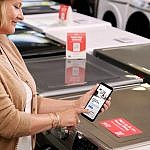Featured in TotalRetail and RetailWit.
Retail has significantly changed in recent years. Buyers were already moving away from in-person retailing before the pandemic hit, and it’s a shift that has picked up considerably since then. For those remaining brick-and-mortar stores, technical advances have been employed to keep customers happy — and keep coming back. Many of the biggest trends in retail have to do with getting a product in the hands of customers. These trends include autonomous delivery, the continuation of the omnichannel experience, and more.
Autonomous Delivery and Fulfillment
Companies such as Starship Technologies, Nuro, among others, have introduced autonomous delivery services in some locations in recent years. Typically used for last-mile deliveries, the robots come in various forms and are already popping up around the globe.
Currently handling thousands of autonomous deliveries every day in several cities around the globe, Starship offers robots focused on food and package deliveries. Nuro, which plans on moving toward robots, is currently a leader in autonomous delivery vehicles. It promises delivery in 30 minutes or less.
Why is autonomous delivery becoming more popular? As Business Insider explains, researchers have determined that 20% of the pollution in cities results from last-mile deliveries. Autonomous delivery robots could help reduce this and also lower overall transportation costs.
Rethinking Supply Chains
Capacity shortfalls, demand surges, labor shortages, and other factors all converged during the pandemic to add stress to the global supply chain. With these disruptions, 2022 could finally be a year of “evaluating, rethinking, and investing” in supply chains for the long term, according to Retail Dive.
As a recent FTI Consulting report explained, “retailers had touted investments in supply chain agility for the past decade, but once their inventory reserves dried up, supply chains proved to be anything but nimble and agile. It became evident that retailers had designed their supply chains to address predictable and specific challenges but had not adequately invested and undergone the end-to-end structural transformation necessary to become truly agile.”
Omni-Channel Commerce
There’s a single channel in the traditional retail model made up of either a physical location or an online store. Eventually, many moved to a multi-channel model that involved brick-and-mortar and online stores. However, things are again changing as omnichannel commerce has started to catch on.
With an omnichannel, customers have access to multiple online and offline sales channels. By doing so, retailers have 24-hour access to consumers, which can build brand loyalty and increase sales. One crucial aspect of omnichannel commerce is the retailer’s ability to create a seamless purchasing and shipping experience, regardless of how a purchase gets made. Without this, problems can arise very quickly.
Logistyx Technologies perhaps says it best, explaining how under an omnichannel, “the merchant can fulfill an order directly from a store… or from a distribution center… or by moving inventory from a distribution center to a store and then fulfilling the order from the store. In doing so, the merchant is better positioned to meet customer expectations for delivery timelines and accuracy.”
Contactless Checkout Plus
The rise of omnichannel commerce is just one of the ways retailers are making it easier for consumers to purchase. For some offline retailers, creating frictionless shopping experiences has become their No. 1 goal to make customers happy. Building upon the Amazon Go concept, frictionless shopping uses advanced vision-based sensors and artificial intelligence (AI) to move contactless checkout beyond self-checkout.
Retailers developing frictionless shopping experiences aren’t just looking out for the customer. The created systems also address inventory and asset protection, notes Retail Dive.
According to Azita Martin, General Manager for AI in Retail and CPG at NVIDIA, “Retailers are looking for ways to improve and differentiate the customer shopping experience, decrease shrinkage and out-of-stock losses and drive incremental purchases. These are the drivers that are fueling the increasing adoption of autonomous store technologies.”
Partner Services
In uncertain times like these, retailers have often tried to increase sales by offering internal services to outside companies. An example of this that relates to delivery comes from one of the world’s largest retailers, Walmart. Its Walmart GoLocal service now allows other companies to access its delivery capabilities.
And then, of course, is the ever-growing popularity of the gig-economy delivery platform. This unique capacity opens opportunities for retailers and drivers alike. Allowing for flexible delivery services for the former and for the latter ways to make significant cash outside of the 9-to-5 grind.
These partners, like Dolly, offer outside the box delivery solutions that look to place the customer at the center of the transaction. Many customers have experienced the quick delivery of groceries or dinner via gig platform, but many may not know that on-demand delivery of big and bulky items, like furniture, mattresses, and appliances is also available.
Traditionally, if the store provides delivery when a customer purchases a new couch, it would be scheduled to arrive sometime within a 4–6-hour window. With disruptions to their schedule and the risk of potential delays, the delivery experience emphasizes that the customer has little control. However, big and bulky purchases often require flexibility from the delivery provider. Customers should have the ability to schedule the delivery at their convenience with options for white glove service, room of choice, assembly, haul-away, and more.
Retailers need to be offering, and will be offering, time-definite delivery, which empowers their customers and puts them in control. It can be a game-changer. Creating an experience that consistently delivers delight can increase sales and drive customer loyalty.
Uncertainty of Inflation
The retailing trends mentioned above sound exciting and have something for companies and consumers alike. But unfortunately, the rapid rise of inflation could disrupt many of these plans across the industry. Price hikes, continued supply chain headaches, and other concerns bought on by inflation could make the rest of the year rocky, at best. Time will tell just how problematic inflation will become. No doubt, it’s something retailers across all sectors are examining closely.
Want to learn more about last-mile deliveries of larger items? Visit dolly.com for information about our best-in-class delivery processes.
Dolly helps you move on your schedule and at an affordable price. Book now and see the difference: https://dolly.com.






